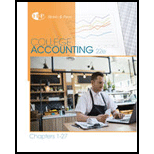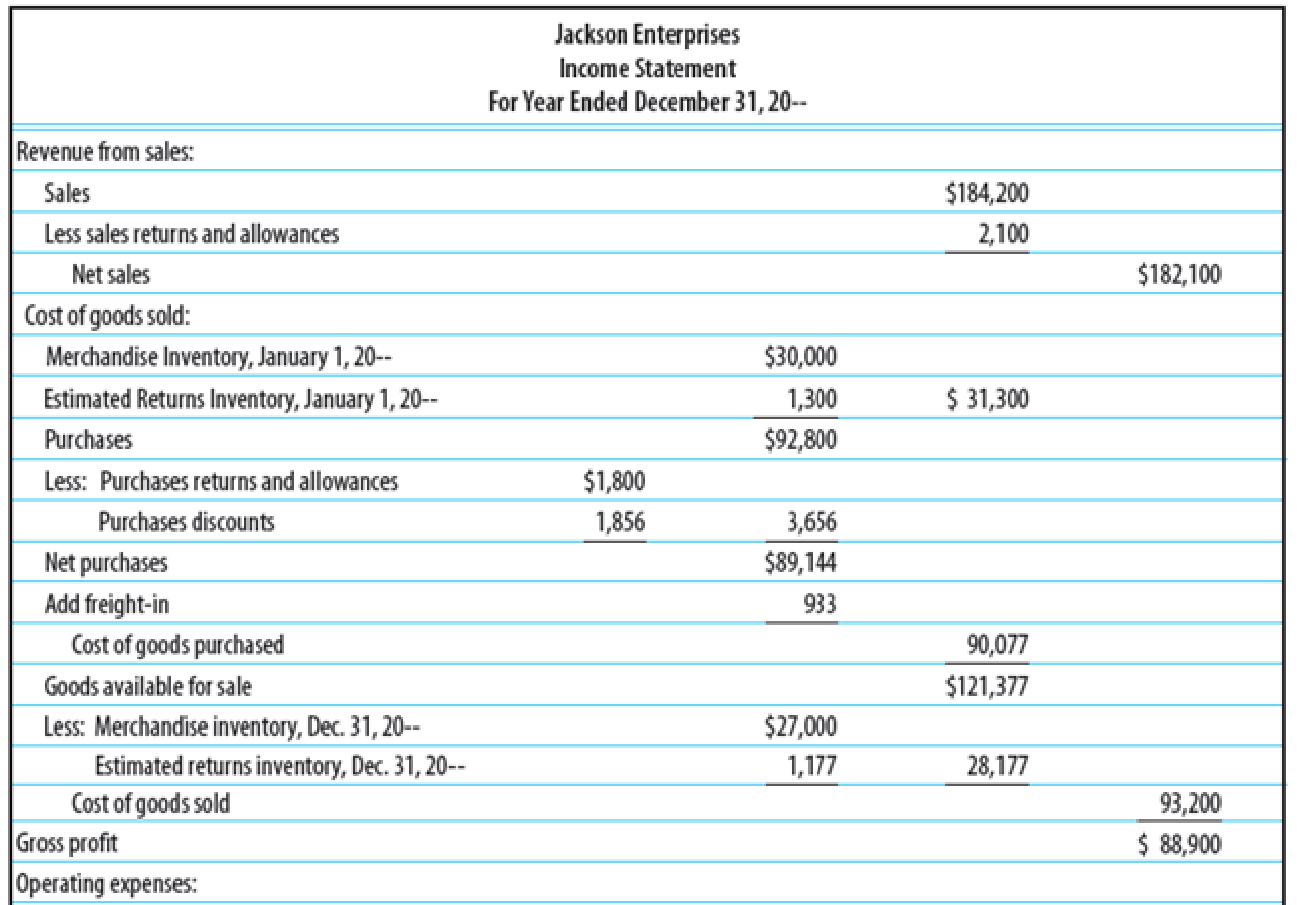
College Accounting, Chapters 1-27
23rd Edition
ISBN: 9781337794756
Author: HEINTZ, James A.
Publisher: Cengage Learning,
expand_more
expand_more
format_list_bulleted
Textbook Question
Chapter 15, Problem 4SEA
FINANCIAL RATIOS Based on the financial statements for Jackson Enterprises (income statement, statement of owner’s equity, and
- 1.
Working capital - 2.
Current ratio - 3. Quick ratio
- 4. Return on owner’s equity
- 5. Accounts receivable turnover and average number of days required to collect receivables
- 6. Inventory turnover and average number of days required to sell inventory




Expert Solution & Answer
Trending nowThis is a popular solution!

Students have asked these similar questions
How does the matching principle impact the recording of expenses? Need help
Please provide the accurate answer to this general accounting problem using valid techniques.
How does the matching principle impact the recording of expenses?
Chapter 15 Solutions
College Accounting, Chapters 1-27
Ch. 15 - LO1 A multiple-step form of income statement...Ch. 15 - Prob. 2TFCh. 15 - Prob. 3TFCh. 15 - Prob. 4TFCh. 15 - LO4 Accounts receivable turnover is the number of...Ch. 15 - Prob. 1MCCh. 15 - Prob. 2MCCh. 15 - Prob. 3MCCh. 15 - Prob. 4MCCh. 15 - Prob. 5MC
Ch. 15 - Prob. 1CECh. 15 - Prob. 2CECh. 15 - Prob. 3CECh. 15 - Prob. 4CECh. 15 - Prob. 5CECh. 15 - Prob. 6CECh. 15 - Prob. 1RQCh. 15 - Prob. 2RQCh. 15 - Describe how to calculate the following ratios (a)...Ch. 15 - Where is the information obtained that is needed...Ch. 15 - Explain the function of each of the four closing...Ch. 15 - What is the purpose of a post-closing trial...Ch. 15 - What is the primary purpose of reversing entries?Ch. 15 - What is the customary date for reversing entries?Ch. 15 - What adjusting entries should be reversed?Ch. 15 - REVENUE SECTION. MULTIPLE-STEP INCOME STATEMENT...Ch. 15 - COST OF GOODS SOLD SECTION, MULTIPLE-STEP INCOME...Ch. 15 - MULTIPLE-STEP INCOME STATEMENT Use the following...Ch. 15 - FINANCIAL RATIOS Based on the financial statements...Ch. 15 - CLOSING ENTRIES Using the spreadsheet and...Ch. 15 - REVERSING ENTRIES From the spreadsheet used in...Ch. 15 - ADJUSTING, CLOSING, AND REVERSING ENTRIES Prepare...Ch. 15 - INCOME STATEMENT, STATEMENT OF OWNERS EQUITY, AND...Ch. 15 - FINANCIAL RATIOS Use the spreadsheet and financial...Ch. 15 - END-OF-PERIOD SPREADSHEET, ADJUSTING, CLOSING, AND...Ch. 15 - REVENUE SECTION, MULTIPLE-STEP INCOME STATEMENT...Ch. 15 - COST OF GOODS SOLD SECTION, MULTIPLE-STEP INCOME...Ch. 15 - MULTIPLE-STEP INCOME STATEMENT Use the following...Ch. 15 - FINANCIAL RATIOS Based on the financial...Ch. 15 - CLOSING ENTRIES Using the spreadsheet and...Ch. 15 - Prob. 6SEBCh. 15 - Prob. 7SEBCh. 15 - INCOME STATEMENT, STATEMENT OF OWNERS EQUITY, AND...Ch. 15 - FINANCIAL RATIOS Use the work sheet and financial...Ch. 15 - END-OF-PERIOD SPREADSHEET, ADJUSTING, CLOSING, AND...Ch. 15 - Prob. 1MYWCh. 15 - Dominique Fouque owns and operates Dominiques Doll...Ch. 15 - Prob. 1CPCh. 15 - Comprehensive Problem 2: Accounting Cycle with...Ch. 15 - Comprehensive Problem 2: Accounting Cycle with...Ch. 15 - Comprehensive Problem 2: Accounting Cycle with...Ch. 15 - Comprehensive Problem 2: Accounting Cycle with...Ch. 15 - Comprehensive Problem 2: Accounting Cycle with...Ch. 15 - Comprehensive Problem 2: Accounting Cycle with...Ch. 15 - Comprehensive Problem 2: Accounting Cycle with...Ch. 15 - Comprehensive Problem 2: Accounting Cycle with...Ch. 15 - Comprehensive Problem 2: Accounting Cycle with...Ch. 15 - Prob. 2.1COPCh. 15 - Comprehensive Problem 2: Accounting Cycle with...Ch. 15 - Comprehensive Problem 2: Accounting Cycle with...Ch. 15 - Prob. 2.4COPCh. 15 - Prob. 2.5COPCh. 15 - Comprehensive Problem 2: Accounting Cycle with...Ch. 15 - Comprehensive Problem 2: Accounting Cycle with...Ch. 15 - Prob. 2.8COP
Knowledge Booster
Learn more about
Need a deep-dive on the concept behind this application? Look no further. Learn more about this topic, accounting and related others by exploring similar questions and additional content below.Similar questions
arrow_back_ios
SEE MORE QUESTIONS
arrow_forward_ios
Recommended textbooks for you
 College Accounting, Chapters 1-27AccountingISBN:9781337794756Author:HEINTZ, James A.Publisher:Cengage Learning,
College Accounting, Chapters 1-27AccountingISBN:9781337794756Author:HEINTZ, James A.Publisher:Cengage Learning, College Accounting, Chapters 1-27 (New in Account...AccountingISBN:9781305666160Author:James A. Heintz, Robert W. ParryPublisher:Cengage Learning
College Accounting, Chapters 1-27 (New in Account...AccountingISBN:9781305666160Author:James A. Heintz, Robert W. ParryPublisher:Cengage Learning Managerial Accounting: The Cornerstone of Busines...AccountingISBN:9781337115773Author:Maryanne M. Mowen, Don R. Hansen, Dan L. HeitgerPublisher:Cengage Learning
Managerial Accounting: The Cornerstone of Busines...AccountingISBN:9781337115773Author:Maryanne M. Mowen, Don R. Hansen, Dan L. HeitgerPublisher:Cengage Learning Managerial AccountingAccountingISBN:9781337912020Author:Carl Warren, Ph.d. Cma William B. TaylerPublisher:South-Western College Pub
Managerial AccountingAccountingISBN:9781337912020Author:Carl Warren, Ph.d. Cma William B. TaylerPublisher:South-Western College Pub

College Accounting, Chapters 1-27
Accounting
ISBN:9781337794756
Author:HEINTZ, James A.
Publisher:Cengage Learning,

College Accounting, Chapters 1-27 (New in Account...
Accounting
ISBN:9781305666160
Author:James A. Heintz, Robert W. Parry
Publisher:Cengage Learning

Managerial Accounting: The Cornerstone of Busines...
Accounting
ISBN:9781337115773
Author:Maryanne M. Mowen, Don R. Hansen, Dan L. Heitger
Publisher:Cengage Learning

Managerial Accounting
Accounting
ISBN:9781337912020
Author:Carl Warren, Ph.d. Cma William B. Tayler
Publisher:South-Western College Pub
Financial ratio analysis; Author: The Finance Storyteller;https://www.youtube.com/watch?v=MTq7HuvoGck;License: Standard Youtube License